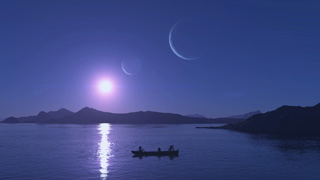The Pearl Button
El botón de nácar FRANCE, CHILE, SPAIN / 2015 / Spanish / Color, B&W / DCP / 82 min
FRANCE, CHILE, SPAIN / 2015 / Spanish / Color, B&W / DCP / 82 min
Director, Script, Editing: Patricio Guzmán
Photography: Katell Djian
Editing: Emmanuelle Joly
Still Photography: Paz Errázuriz, Martin Gusinde
Producer: Renate Sachse
Production Company: ATACAMA Productions
World Sales: Pyramide International www.pyramidefilms.com
Distribution Company in Japan: Uplink
The western coast of Patagonia in southern Chile was once the homeland of native peoples who revered water and stars as symbols of life. A single pearl button discovered here links the story of their genocide at the hands of colonizers, with the history of those who were killed and discarded into the sea by Pinochet’s reign of terror. Breathtaking imagery resonates against the eternity of time that seems to rush through the currents of sea and sky. The graceful tone of Patricio Guzmán’s narration brings to mind the multiplicity of memories and voices lost in the depths of the waters.
[Director’s Statement] Western Patagonia is the largest existing cluster of archipelagos. Located in the south of Chile it has endless islands, islets, rocks and fjords. There are estimated to be around 46,000 miles of coastline. Parts of this region have never been explored. It encompasses the far south of the continent and stretches from the Gulf of Penas to Isla de los Estados (at the southernmost point of South America). This immense labyrinth of water reminds us of man’s aquatic origins. According to the German scientist Theodor Schwenk, the inner ear is a winding mollusk, the heart is the meeting of two underwater currents, and some of the bones in our bodies are coiled in a spiral, like a whirlpool.
Water doesn’t just belong to earthlings. It is a common element in the Solar System. It is found in the form of vapor in some planets: Jupiter and Saturn. It is found as ice on Mars, the Moon, Europa, and Titan. Beyond the Solar System there is also a lot of water in other bodies. In Chile, in 2010, a few stars were detected from the La Silla Observatory that may contain liquid water and that orbit the planet Gliese, in the constellation Libra, twenty light years away from the Earth. At present, nobody can deny the possible existence of an archipelago such as Patagonia there.
Making a film about these places also inspired me to film part of its inhabitants’ history. In the words of Theodor Schwenk, “The act of thinking resembles water due to its capacity to adapt to everything. The law of thought is the same as that of water, always ready to adapt itself to everything.” Perhaps this explains how a group of humans managed to live here for ten thousand years, isolated and in polar temperatures, with winds of 124 miles per hour. It is thought there were eight thousand people in the eighteenth century. Now, around twenty direct survivors remain.
 Patricio Guzmán
Patricio GuzmánBorn in 1941 in Santiago, Chile. Patricio Guzmán studied at the Official Film School in Madrid, where he specialized in documentary cinema. After the coup d’etat that brought down Salvador Allende, he was held in solitary confinement in Santiago’s National Stadium and threatened with execution. He abandoned Chile in November 1973. He has since lived in Cuba, Spain and France, where he lives now. Six of his works have been premiered at the Cannes Film Festival, amongst which stand out The Battle of Chile—The Struggle of an Unarmed People, The Pinochet Case (2001), Salvador Allende (2004) and Nostalgia for the Light (2010, YIDFF 2011 The Mayor’s Prize). The latter was awarded Best Documentary by the European Film Academy of Arts and Science in 2010. He is the founder of the International Documentary Film Festival of Santiago. Recent retrospectives of his work have been held at the British Film Institute and the Harvard Film Archive, and in 2013 he was invited to be part of the Hollywood Academy of Arts and Science.
